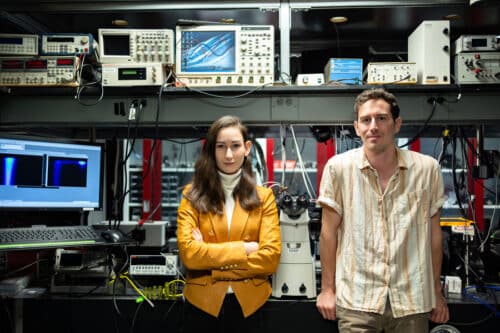The study shows how nanotechnology improves perovskite solar cells, making them efficient and stable for sustainable energy.

Credits:Photo: Courtesy of the researchers
Perovskites are a promising alternative to traditional silicon solar panels, offering potential advantages in being lightweight, inexpensive, and versatile. They can be coated onto various substrates and are becoming comparable to silicon in converting sunlight to electricity. However, their longevity is a significant drawback, as they tend to break down within months to years, while silicon panels can last over two decades. Additionally, their efficiency over large areas still needs to catch up to silicon.
A team of researchers at MIT and several other institutions has discovered ways to optimize efficiency and better control degradation in perovskite solar cells by engineering their nanoscale structure. The study offers new insights into creating high-efficiency perovskite solar cells and provides valuable guidance for engineers aiming to commercialize these solar cells.
The new study addressed the ability to passivate interfaces and elucidate the physics and science behind the effectiveness of this passivation, according to Bulovic. The team employed some of the most powerful instruments available at laboratories worldwide to observe the interfaces between the perovskite layer and other materials in unprecedented detail.
While the bulk of a perovskite material consists of a perfectly ordered crystalline lattice of atoms, this order breaks down at the surface, where there may be extra atoms or vacancies causing defects that lead to efficiency losses. Passivation addresses this issue by reducing the energy loss of electrons at the surface after they have been excited by sunlight, thereby boosting the overall efficiency of sunlight-to-electricity conversion. Rapid improvements in the materials’ efficiency could result from this approach. Recent efficiency records for a single perovskite layer, several of which were set at MIT, have ranged from about 24 to 26 per cent, while the maximum theoretical efficiency is estimated to be about 30 per cent.
Many studies in this field have been based on observation, with the underlying mechanisms still needing to be fully understood. This study shows that treatments can passivate defects and create a surface field that repels carriers, which should improve the interfaces.
The post Improving Perovskite Solar Cells With Nanotechnology appeared first on Electronics For You.
View more at https://www.electronicsforu.com/news/improving-perovskite-solar-cells-with-nanotechnology.
Credit- EFY. Distributed by Department of EEE, ADBU: https://tinyurl.com/eee-adbu
Curated by Jesif Ahmed